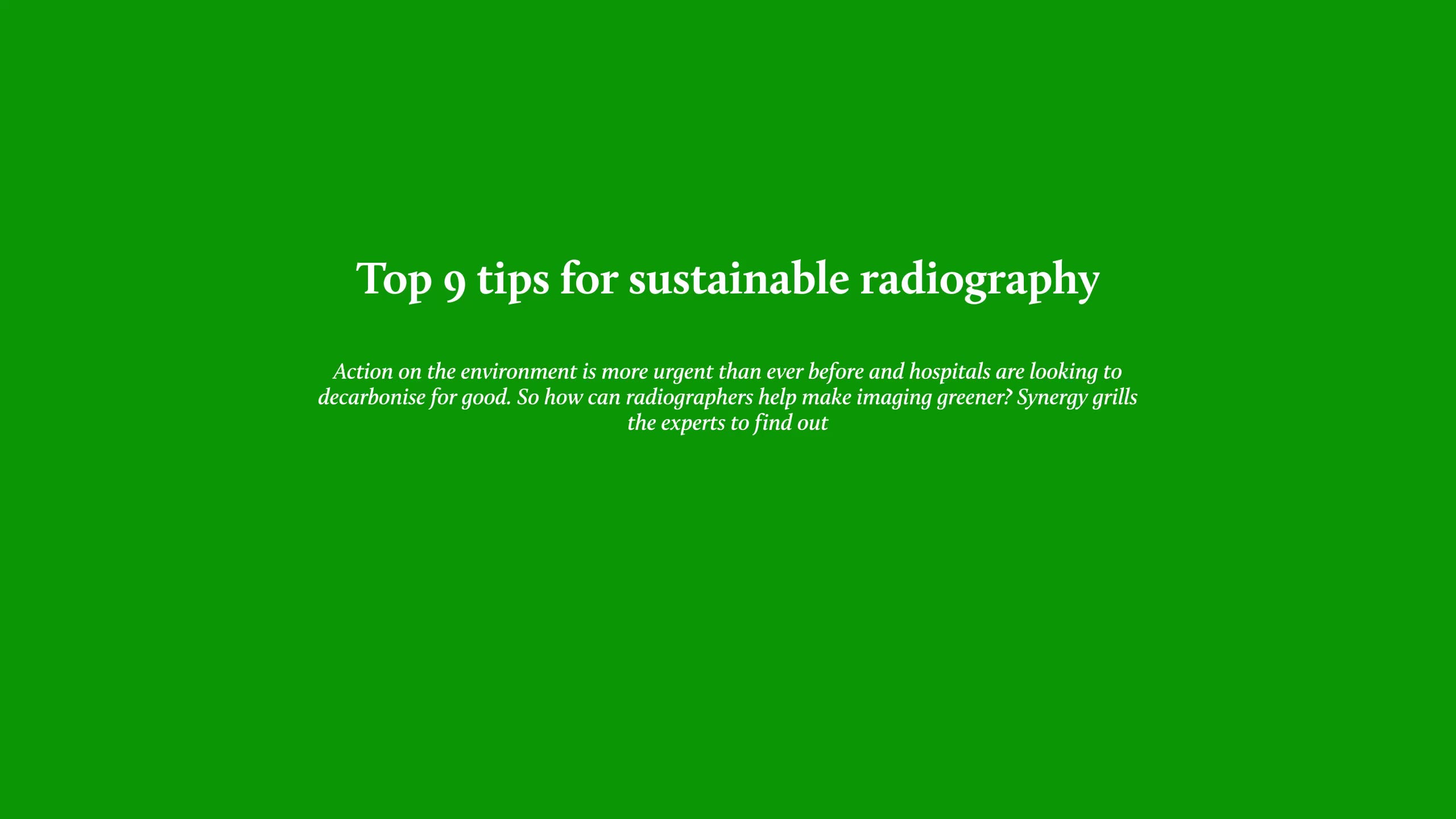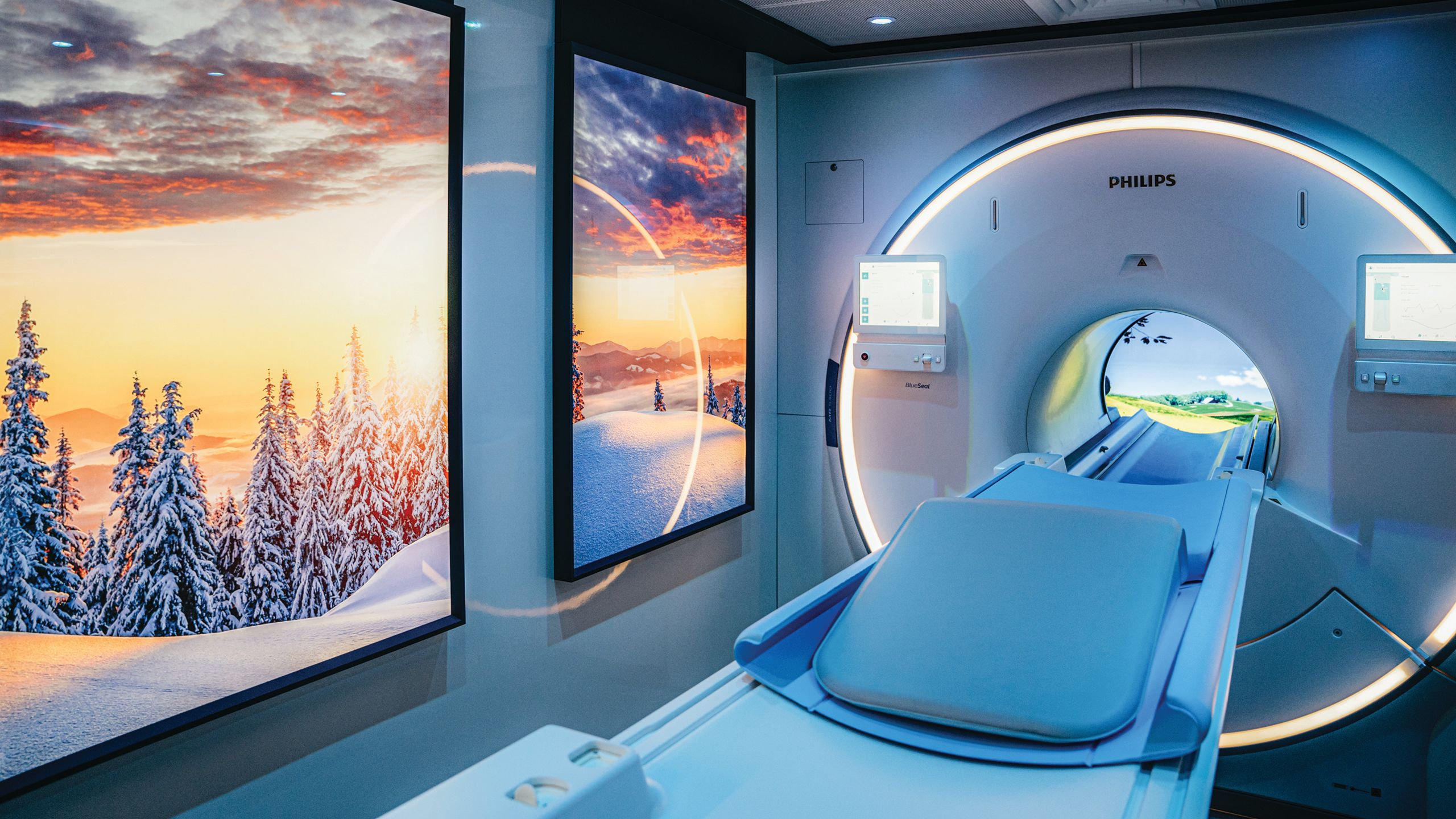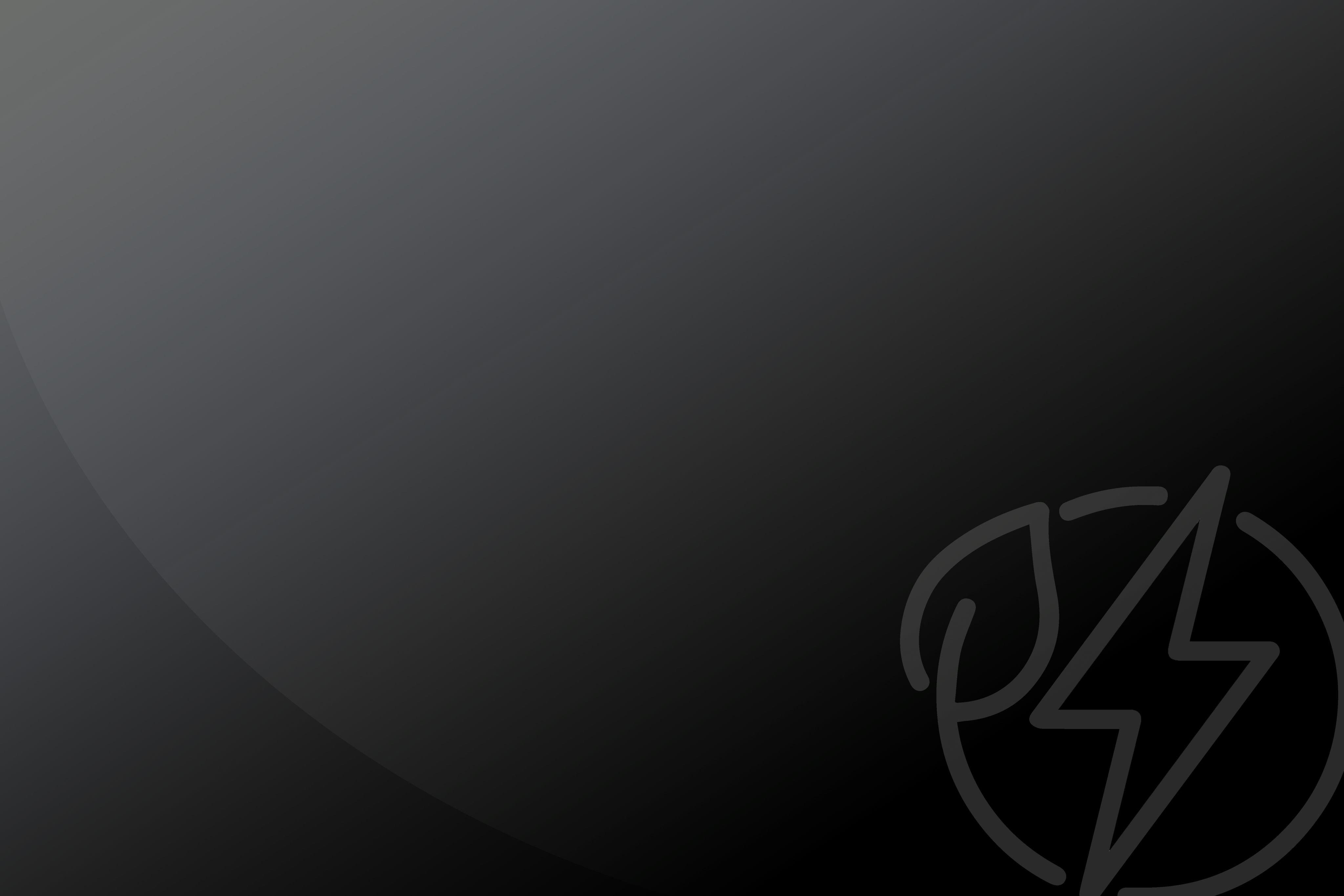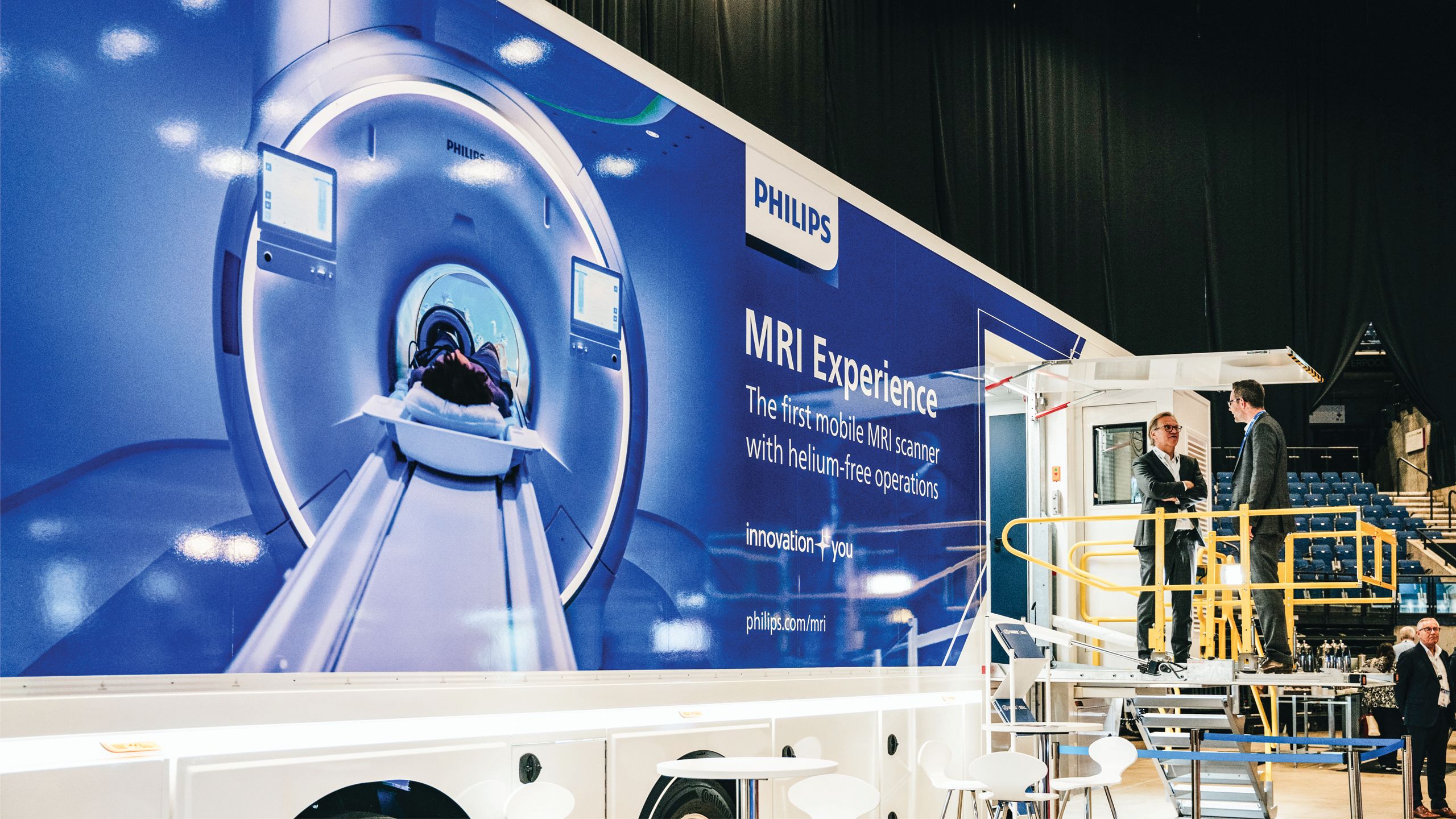
In 2019, carbon emissions from the healthcare sector across the globe stood higher than both those of the aviation and marine industries. Where aviation makes up 3 per cent of global emissions and shipping 2 per cent, healthcare stands at 4.4 per cent.
Radiography contributes around 1 per cent of the world’s total carbon emissions, according to a “conservative estimate” published by the National Library of Medicine in 2022. But nine in 10 patients will be supported by a radiographer during their time in hospital, making its impact necessary.
All is not lost – research across the industry, scientific journals, radiographers and departments in the UK have been investigating potential methods to help reduce the profession’s environmental impact.
Synergy sought out the experts to find the top nine tips for implementing practical sustainability solutions.
Energy use during non-operational times (after hours and weekends), where MRI, CT, PET/CT, SPECT/CT and angiography systems are left powered up, has been identified as a potential energy saving of 20-60 per cent by researchers. In fact, for CT machines, two thirds of energy consumption takes place during the ‘idle’ system state. For MRI, one third of its energy consumption is dedicated to the ‘system off’ state.
While medical imaging is not easily powered down, explain the authors in a study published in the Radiography journal, reducing these ‘active’ standby modes to a ‘passive’ standby could represent a significant energy saving, certainly for CT if not for MRI (which requires more energy for helium cooling).
These active modes consume three times as much energy as passive modes do. By switching machines to passive mode overnight, or by putting one machine into standby to better streamline scanning, departments can reduce their impact on the environment.
At this year’s SoR Annual Delegates Conference, attendees voted in favour of a motion to initiate a Switch It Off campaign to shut down such machines or put them in passive mode overnight.

Energy use during non-operational times (after hours and weekends), where MRI, CT, PET/CT, SPECT/CT and angiography systems are left powered up, has been identified as a potential energy saving of 20-60 per cent by researchers. In fact, for CT machines, two thirds of energy consumption takes place during the ‘idle’ system state. For MRI, one third of its energy consumption is dedicated to the ‘system off’ state.
While medical imaging is not easily powered down, explain the authors in a study published in the Radiography journal, reducing these ‘active’ standby modes to a ‘passive’ standby could represent a significant energy saving, certainly for CT if not for MRI (which requires more energy for helium cooling).
These active modes consume three times as much energy as passive modes do. By switching machines to passive mode overnight, or by putting one machine into standby to better streamline scanning, departments can reduce their impact on the environment.
At this year’s SoR Annual Delegates Conference, attendees voted in favour of a motion to initiate a Switch It Off campaign to shut down such machines or put them in passive mode overnight.

Reducing energy usage during off hours is not only a strategy that can be implemented for scanning machines themselves. The energy costs associated with workstations and lighting of departments during out-of-hours periods is a noted area of inefficiency, one also highlighted in the ADC Switch It Off campaign motion.
Researchers in Ireland developed recommendations for improving this, including with “optimised technical imaging approaches that require lower energy consumption”.
While such techniques were noted to have potentially significant impact, an article published in Radiography found energy wastage in radiography departments is mostly associated with lights, workstations and picture archiving and communication systems (PACS) left on even when departments are closed. It found that at one point 67.4 per cent of desktops, and 92.6 per cent of PACS reporting workstations, had been left switched on after the department closed.
The article added: “These revelations are indicative of poor attention to energy sustainability and its environmental and economic repercussions and, more importantly, represent huge opportunities for greening radiology and radiotherapy practice.”

Reducing energy usage during off hours is not only a strategy that can be implemented for scanning machines themselves. The energy costs associated with workstations and lighting of departments during out-of-hours periods is a noted area of inefficiency, one also highlighted in the ADC Switch It Off campaign motion.
Researchers in Ireland developed recommendations for improving this, including with “optimised technical imaging approaches that require lower energy consumption”.
While such techniques were noted to have potentially significant impact, an article published in Radiography found energy wastage in radiography departments is mostly associated with lights, workstations and picture archiving and communication systems (PACS) left on even when departments are closed. It found that at one point 67.4 per cent of desktops, and 92.6 per cent of PACS reporting workstations, had been left switched on after the department closed.
The article added: “These revelations are indicative of poor attention to energy sustainability and its environmental and economic repercussions and, more importantly, represent huge opportunities for greening radiology and radiotherapy practice.”


High concentrations of gadolinium contrast medium have been found in various water sources around the world. The potentially toxic nature of contrast by-products is a “critical concern”, according to researchers, because of the depletion of aquatic ecosystems and the cost of freshwater treatment.
With around 300 million CT exams performed around the world annually, and an estimated 10 million litres of contrast agents being used, it is more important than ever that sustainable approaches to these materials are adopted. Retrieving contrast media agents post examination is required to preserve the ecosystem, while reducing the cost of water purification.
The research suggests potential solutions could include patients waiting in the radiology department for their urine to be collected after contrast media examinations for extraction. However, it acknowledges the challenges of stakeholder cooperation, time and the additional resource such a requirement would entail. Nonetheless, it suggests leftover contrast media could be collected within departments and returned to manufacturers for recycling, in accordance with ‘circular economy’ principles.

High concentrations of gadolinium contrast medium have been found in various water sources around the world. The potentially toxic nature of contrast by-products is a “critical concern”, according to researchers, because of the depletion of aquatic ecosystems and the cost of freshwater treatment.
With around 300 million CT exams performed around the world annually, and an estimated 10 million litres of contrast agents being used, it is more important than ever that sustainable approaches to these materials are adopted. Retrieving contrast media agents post examination is required to preserve the ecosystem, while reducing the cost of water purification.
The research suggests potential solutions could include patients waiting in the radiology department for their urine to be collected after contrast media examinations for extraction. However, it acknowledges the challenges of stakeholder cooperation, time and the additional resource such a requirement would entail. Nonetheless, it suggests leftover contrast media could be collected within departments and returned to manufacturers for recycling, in accordance with ‘circular economy’ principles.

An overview of sustainability in Radiography suggests that the optimisation of image acquisition protocols could play a role in reducing environmental impacts. It says that by ‘rationalising’ sequencing, and adopting AI augmentation into image acquisition protocols, energy efficiencies could be found.
Researchers agree that image rationalisation is a possible method to reduce waste, as they found some estimates that 50 per cent of imaging procedures are unnecessary, while a 34-60 per cent overuse was reported in radiology. “Reducing unnecessary procedures or low-value procedures would have a significant impact on the carbon footprint of medical imaging,” they conclude.

An overview of sustainability in Radiography suggests that the optimisation of image acquisition protocols could play a role in reducing environmental impacts. It says that by ‘rationalising’ sequencing, and adopting AI augmentation into image acquisition protocols, energy efficiencies could be found.
Researchers agree that image rationalisation is a possible method to reduce waste, as they found some estimates that 50 per cent of imaging procedures are unnecessary, while a 34-60 per cent overuse was reported in radiology. “Reducing unnecessary procedures or low-value procedures would have a significant impact on the carbon footprint of medical imaging,” they conclude.

A further suggestion made by researchers in Thieme and agreed to in Radiography is that nuclear medicine imaging as a whole faces such severe issues of waste footprints and disposal that replacing them entirely is the only way to improve radiography’s sustainability. Non-radioactive diagnostic methods should be used instead, they argue, replacing MRI, CT, X-ray and other imaging modalities entirely with ultrasound.
However, the study in Thieme acknowledges such a change would be difficult to implement and could result in reduced quality of patient care. Instead, it argues that perhaps, while considering the best imaging modality to use, the cost of carbon offsetting should be factored in.
Including optional costs for carbon offset could reduce the net footprint while educating patients about environmental sustainability. Patients could be given the option of paying an additional fee for carbon offset.

A further suggestion made by researchers in Thieme and agreed to in Radiography is that nuclear medicine imaging as a whole faces such severe issues of waste footprints and disposal that replacing them entirely is the only way to improve radiography’s sustainability. Non-radioactive diagnostic methods should be used instead, they argue, replacing MRI, CT, X-ray and other imaging modalities entirely with ultrasound.
However, the study in Thieme acknowledges such a change would be difficult to implement and could result in reduced quality of patient care. Instead, it argues that perhaps, while considering the best imaging modality to use, the cost of carbon offsetting should be factored in.
Including optional costs for carbon offset could reduce the net footprint while educating patients about environmental sustainability. Patients could be given the option of paying an additional fee for carbon offset.

Philips has developed an MRI scanner that makes use of no helium, one of the primary sources of sustainability issues within the modality.
Representatives from Philips spoke to Synergy about the development, explaining that one of the problems with helium as a necessary requirement for MRI is that it is a finite resource.
“[Helium is] scarce, and the supply is limited,” says Ruud Zwerink, global business leader for MR. “If you look at the last couple of years, the demand and the prices have just gone up. Five, 10 years down the road? It won’t be about the price, it will be about the availability.”
MRI systems sometimes release helium, which can cause the system to become non-functional. A scanner without helium, therefore, has a lower carbon footprint, is less prone to breakage and secures more uptime.
Philips’s BlueSeal scanner requires only 0.5 per cent of the helium a conventional MRI needs. It is cheaper to run and requires no replacement of helium throughout its lifetime.

Philips has developed an MRI scanner that makes use of no helium, one of the primary sources of sustainability issues within the modality.
Representatives from Philips spoke to Synergy about the development, explaining that one of the problems with helium as a necessary requirement for MRI is that it is a finite resource.
“[Helium is] scarce, and the supply is limited,” says Ruud Zwerink, global business leader for MR. “If you look at the last couple of years, the demand and the prices have just gone up. Five, 10 years down the road? It won’t be about the price, it will be about the availability.”
MRI systems sometimes release helium, which can cause the system to become non-functional. A scanner without helium, therefore, has a lower carbon footprint, is less prone to breakage and secures more uptime.
Philips’s BlueSeal scanner requires only 0.5 per cent of the helium a conventional MRI needs. It is cheaper to run and requires no replacement of helium throughout its lifetime.


Philips’s new helium-less MRI scanner on display at UKIO 2024
Philips’s new helium-less MRI scanner on display at UKIO 2024
Recycling single-use items is one of the simplest ways in which departments can get started on their sustainability journey. Doing so can not only help reduce environmental impacts but can save on the cost of repeat purchases.
Zankhana Jani, digital lead radiographer at the Royal Marsden NHS Foundation Trust, tells Synergy about how their radiotherapy department had started improving their recycling process. She explains one way they have done so is removing paper cups, instead providing patients with their own water bottles. These not only helped regulate their water intake with the use of watermarks – an important aspect of their treatment – but meant they did not have to use and discard numerous paper cups. “Patients get a water bottle at the start of their treatment that they keep for the whole period,” she says. “It’s plastic, but it’s recycled plastic.”
Going paperless has also meant reducing the physical materials, such as consent forms or patient information, being distributed through paper. Instead, much of this is now online.
Zankhana says her department similarly provides gowns for usage throughout their treatment, which are not discarded but which instead patients take home and wash. Further, forks and knives in their canteen have been replaced with wooden versions, which have a lower carbon footprint than plastic disposable versions. “Patients quite like that,” she says. “They don’t have to use a new gown every day. And the water bottles give them exact measurements, which they get quite stressed about. It’s more comfortable for them. And a lot of patients are becoming more environmentally conscious.”

Recycling single-use items is one of the simplest ways in which departments can get started on their sustainability journey. Doing so can not only help reduce environmental impacts but can save on the cost of repeat purchases.
Zankhana Jani, digital lead radiographer at the Royal Marsden NHS Foundation Trust, tells Synergy about how their radiotherapy department had started improving their recycling process. She explains one way they have done so is removing paper cups, instead providing patients with their own water bottles. These not only helped regulate their water intake with the use of watermarks – an important aspect of their treatment – but meant they did not have to use and discard numerous paper cups. “Patients get a water bottle at the start of their treatment that they keep for the whole period,” she says. “It’s plastic, but it’s recycled plastic.”
Going paperless has also meant reducing the physical materials, such as consent forms or patient information, being distributed through paper. Instead, much of this is now online.
Zankhana says her department similarly provides gowns for usage throughout their treatment, which are not discarded but which instead patients take home and wash. Further, forks and knives in their canteen have been replaced with wooden versions, which have a lower carbon footprint than plastic disposable versions. “Patients quite like that,” she says. “They don’t have to use a new gown every day. And the water bottles give them exact measurements, which they get quite stressed about. It’s more comfortable for them. And a lot of patients are becoming more environmentally conscious.”

Implementing low-carbon techniques in departments is done most effectively when efforts can be targeted where they will have the greatest impact, according to Rob Chuter, chair of the Radiotherapy Board’s Environmental Sustainability (RTBES) Working Group.
He tells Synergy that the board has been working to track the carbon footprint of as much of radiotherapy’s impact as possible, conducting studies on brachytherapy, proton beam therapy and PET/SPECT to understand the specifics of their impacts. “It’s not too difficult to do,” says Rob. “Essentially you just do an audit where you measure everything you’re using – how far patients have travelled, how many scans they’ve done. Then you can find conversion factors from literature, or government databases. You just measure lots of things.”
Once these measurements are in place, he explains, then departments can go about the business of both finding efficiencies and targeting their largest impact factors, with a greater knowledge of which areas need the most attention.

Implementing low-carbon techniques in departments is done most effectively when efforts can be targeted where they will have the greatest impact, according to Rob Chuter, chair of the Radiotherapy Board’s Environmental Sustainability (RTBES) Working Group.
He tells Synergy that the board has been working to track the carbon footprint of as much of radiotherapy’s impact as possible, conducting studies on brachytherapy, proton beam therapy and PET/SPECT to understand the specifics of their impacts. “It’s not too difficult to do,” says Rob. “Essentially you just do an audit where you measure everything you’re using – how far patients have travelled, how many scans they’ve done. Then you can find conversion factors from literature, or government databases. You just measure lots of things.”
Once these measurements are in place, he explains, then departments can go about the business of both finding efficiencies and targeting their largest impact factors, with a greater knowledge of which areas need the most attention.

Louise Turtle is the lead research and development radiographer at the Clatterbridge Cancer Centre, where the team is working to implement various sustainability initiatives across the department. She highlights the importance of raising awareness.
While Louise’s sustainability action group has only just begun its journey, she says the centre is beginning to introduce ‘sustainability guardians’, each covering a different site within the centre’s operations, to manage easy initiatives such as workstation shutdowns.
Appointing people within the department to explicit sustainability positions, establishing green meeting groups and feeding back to team members about the overall sustainability plan are all part of efforts to raise awareness, she explains. “Some people will be really conscious about this topic, but for some it just won’t be part of their thinking,” Louise explains. “We just need to raise awareness. The more things you do, the more natural it is for people to keep it in mind. Don’t wait for someone else to do it.
“If everyone starts doing little things, it might not make a huge difference now, but it’ll change mindsets. Then, it’s more likely to become integrated as normal.”

Louise Turtle is the lead research and development radiographer at the Clatterbridge Cancer Centre, where she is working to implement various sustainability initiatives across the department. She highlights the importance of raising awareness.
While Louise’s department has only just begun its sustainability journey, she says the centre is beginning to introduce ‘sustainability guardians’, each covering a different site within the centre’s operations, to manage easy initiatives such as workstation shutdowns.
Appointing people within the department to explicit sustainability positions, establishing green meeting groups and feeding back to team members about the overall sustainability plan are all part of efforts to raise awareness, she explains. “Some people will be really conscious about this topic, but for some it just won’t be part of their thinking,” Louise explains. “We just need to raise awareness. The more things you do, the more natural it is for people to keep it in mind. Don’t wait for someone else to do it.
“If everyone starts doing little things, it might not make a huge difference now, but it’ll change mindsets. Then, it’s more likely to become integrated as normal.”

More about sustainability in radiography
The Society of Radiographers is dedicated to helping radiographers reduce the environmental impact of healthcare.
Find out more about the sustainability in radiography here
Image credit: Eva Slusarek
tetyanka / Creatas Video+ / Getty Images Plus
Read more






















